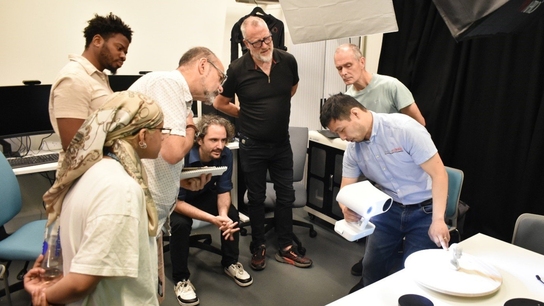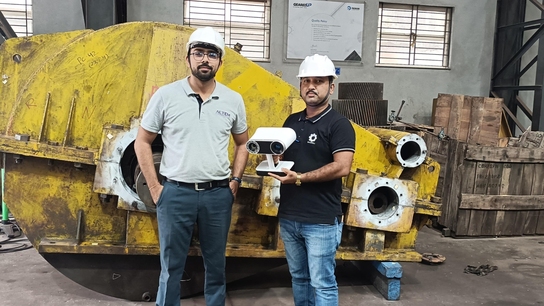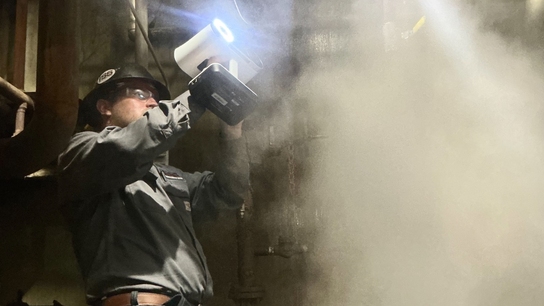Digitizing ‘Buddy’ the horse with Artec Leo so riders can stride with style
Challenge: Digitizing ‘Buddy,’ a living, breathing horse with such accuracy that measurements can be used to customize equestrian gear for a perfect fit.
Solution: Artec Leo, Artec Studio
Result: Highly detailed scans of a ranch horse’s back, head, and hooves, which capture all the features required for saddle, bridle, and shoe customization. It’s also thought that 3D scanning could have veterinary applications, with 3DMakerWorld already receiving enquiries.
Why Artec 3D?: With advanced color and geometry tracking, Artec Leo can digitize living beings prone to small movements, without needing targets. Artec Studio also facilitates the capture of difficult-to-scan surfaces like dark, shiny hair with HD Mode, while streamlining scan fusion for the seamless creation of lifelike 3D models.

’Cowboy Coop,’ son-in-law of 3DMakerWorld’s Kevin Stucky, riding ‘Buddy’ the horse. Image courtesy of 3DMakerWorld
Wherever you look, from racing to rural farming, horses continue to hold a special place in our collective history, culture, and agricultural practices.
While our reliance on horses for transport has eased with the advent of automotive technology, they’re still counted upon in other ways. This is not only the case at farms, where they remain a critical source of horsepower, but at stables where they’re simply bred as companions.
Despite being so expensive to keep, people continue to ride, train, and form close bonds with equine friends, both casually and for competitions like show jumping and dressage.
In fact, equestrian events are still so popular that a whole industry has flourished around them, selling outfits and accessories for jockeys and horses alike. However, making these to size is tricky. It’s hard enough to sit people still for measuring, horses are on another level!
You could try using digital measurement tools like low-end 3D scanners. But many of these rely on targets (try sticking those to a horse) and such devices often struggle to track living, breathing beings. So, how do you create custom equestrian gear fit for the modern world?
According to 3DMakerWorld, a Gold-certified Artec 3D partner with extensive data capture expertise and close personal ties to a remote US ranch, Artec Leo is the answer.

3DMakerWorld’s Buddy scan – with detailed head, back, and hoof capture. Image courtesy of 3DMakerWorld
Riding high with Artec Leo
3DMakerWorld’s equine digitization deep dive began when it was approached by a potential customer looking for a way to more closely customize deluxe riding gear to horses.
To showcase the services they could offer this equipment manufacturer, 3DMakerWorld scanning consultant Kevin Stucky says he needed a ‘proof of concept.’ There was no chance of getting across-state to the customer in time, and who has everyday access to any horse, let alone one that won’t get spooked by flashing during data capture?
Luckily, Stucky had just the solution. As it turned out, his son-in-law kept a horse named Buddy, who was familiar enough to stay calm through 3D scanning, and within driving distance of his Kansas office.
3DMakerWorld sells many 3D scanners, but in this case, Artec Leo was the clear choice. The device’s unique wireless nature, as well as its built-in battery, display, and powerful processor, meant that deploying it was simply a case of driving there and booting it up.
When it came to capture, Leo’s large working distance and field of view made digitizing a large, heavily breathing horse so much easier. Activating HD Mode also ensured Stucky could pick up the finest hair-obscured details, all while relying solely on geometry and color tracking.
“Digitizing Buddy would have been virtually impossible with targets or anything like that,” explained Stucky. “That’s where Leo – and actually Artec technology in general – really shines. You don’t need any markers, it uses geometry and color for tracking.”

A 3D mesh of Buddy the horse’s head, featuring enough detail for customization. Image courtesy of 3DMakerWorld
‘Working a little magic’ in Artec Studio
As well as Buddy behaved himself during 3D scanning, Stucky says colleague Chad Mees had to “work a little magic” in the Artec Studio software, to bring a few overlapping scans together. This was particularly important around areas like the hooves, which were lifted, scanned, and aligned to their respective legs, to maximize detail capture.
With its extensive editing toolkit, Artec Studio made quick work of aligning and tidying data into textured meshes, and the results speak for themselves. Initially, Mees says the prospective client was so concerned “they thought even short hair would be a problem.”
Yet, the end model actually features many tiny details, from pigmentation changes to much of the horse’s mane, and most importantly, geometry has been captured brilliantly. As such, the duo say they have all the data they’d need to kit Buddy out with custom equipment.
With future scans, they reckon there’s still room to improve their process even further. It’s thought that turning Leo’s flash off would help reduce micro-movements while scanning without registration on Artec Studio would allow for better tracking and full 3D data capture.
But for Mees, who entered the project at the data processing stage, Artec Studio’s default tracking, texture capture, and alignment algorithms still yielded outstanding results.
“I had no knowledge of what was captured until I got the file. So HD Mode really helped by giving me that flexibility to fill in harder-to-capture areas, around the nostrils, things like that,” Mees added. “We only used certain regions, the rest was removed. But Artec Studio just made piecing all these components together so quick and easy.”

Buddy’s raised hoof, complete with all its tiny cavities and crevices. Image courtesy of 3DMakerWorld
No time for horsing around
At first glance, 3DMakerWorld’s equine digitization project may sound like some experimental fun, but Stucky is adamant that it shows how 3D scanning can address a real-world need.
Everyday equipment like saddles have to be fitted exactly to prevent unwanted slipping, which is uncomfortable for horses. With Artec Leo, he says it’s possible to customize these so they “fit exactly to how the horse is structured,” and contour to provide support where it’s needed.
Since scanning Buddy, 3DMakerWorld has also received interest from a veterinarian, and they now believe a similar approach could be used for equestrian orthosis customization.
“The project started out as a proof of concept, but then we had a vet show some interest, and that got us thinking,” added Stucky. “What if we could make custom orthoses for horses? There could also be pads to keep medicine inside of hooves. That could be the next step.”
“It’s kind of an unusual case study, but it really shows the strength of Artec 3D scanning when you need to digitize living, moving beings.”
Scanners behind the story
Try out the world's leading handheld 3D scanners.





